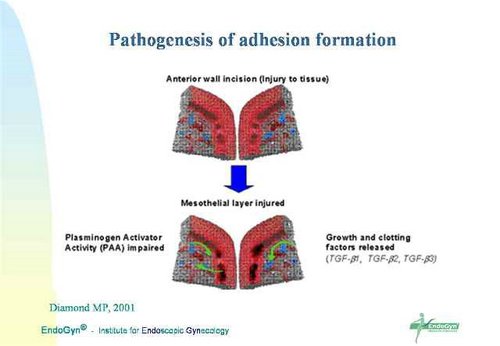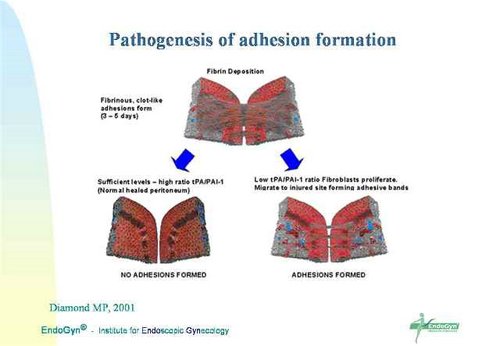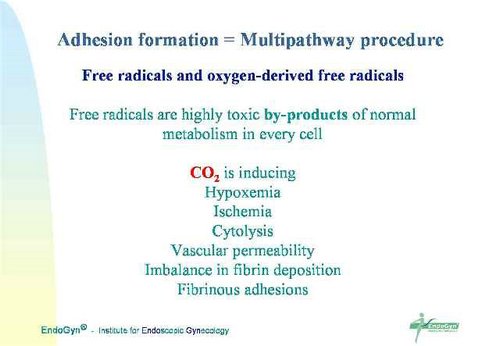Comments on CO2 and adhesions
Comment on adhesions formation by using carbon dioxide gas
I'm not speaking about MY PERSONAL PREFERENCE how to perform surgery, as "I would say, I drink tea with milk, as it tastes better, others drink without …",
I'm speaking about the evident data that is collected and published by experimental studies and clinical reaserch !
Not the "postoperative effects on the body" are important, but the destructive effect of carbon dioxide that causes injury / lesion to the peritoneum and by this causes adhesion formation !!!
First of all, please look at Shirlis biochemical explanation here:
And here are some pictures of a lecture on an international congress where I was presenting the data and the images of systematically collected data from 33 patients with an follow-up of more than 80 ! months, that show the excellent results of over 85 % adhesion and pain free patients, treated with gasless lift-laparoscopy in combination with SprayGel.
Here is the pathogenesis of adhesion formation



An healing process governs many procedures and in fact is a multipathway procedure (including blood clotting, fibrinolysis of blood clots and angiogenesis- rebuilding of capillaries and vessels) in which each pathway is a multistep one.
This all involves many and different types of cells. Theses cells, inflammatory and immune cells, mesothelial cells and fibroblast, release molecules that modulates the subsequent evolution of the peritoneal lesion to normal healing or to adhesion formation (depends on there amount and timing).

Free radicals are highly toxic by-products of normal metabolism in every cell.
Free radicals usually react with oxygen and the body has special enzymatic mechanisms to get rid of them. When the free radicals are not efficientyremoved or metabolized (especially when their amount is too high) they will react with or attack any macromolecules like DNA or fattyacids in the cell membrane and proteins. Consequently a wide variety of cells including endothelial cells (cells that cover blood vessels and soft tissues), erythrocytes (red blood cells), platelets and fibroblasts (participate in blood clotting and fibrinolysis) are damaged and therefore several procedures are getting totally out of balance …
Lack of oxygen in and around the cells is evidently caused by using CO2 gas as is usually being done in an endoscopic surgery (!)…
Already after 5 minutes of ischemia there is a significant production of free radicals that have not enough oxygen to react with. Therefore free radicals will be initiating adhesion formation, starting with cytolysis of these cells (cells are broken) and peroxidation of lipids in cell membrane that lead to an increase in the vascular permeability that cause among other things (damage that produce adhesions) also an imbalance in fibrin deposition and fibrin dissolution (blood clotting and dissolution of the clots) which produce fibrinous adhesions
Using carbon dioxide gas we are inducing adhesion formation by lowering the level of special molecules that are needed for the healing process and so carbon dioxide is an (for the surgeon) unvisible instrument that causes injury (lesion) to the peritoneum with the result of adhesion formation !

We have to believe evident data and trying to reduce surgery that might not help to avoid adhesion formation.
Please see also surgical results and comments on gasless laparoscopy section.





